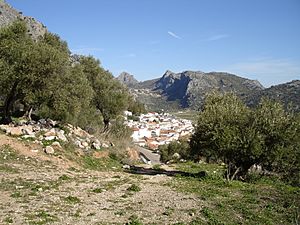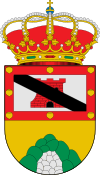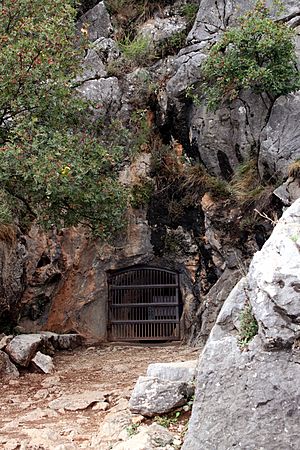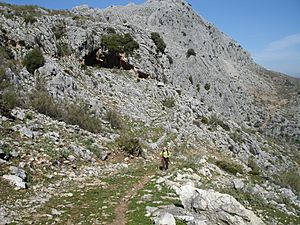Benaoján facts for kids
Quick facts for kids
Benaoján
|
||
|---|---|---|
 |
||
|
||
| Country | ||
| Autonomous community | ||
| Province | Málaga | |
| Area | ||
| • Total | 32 km2 (12 sq mi) | |
| Elevation | 524 m (1,719 ft) | |
| Population
(2018)
|
||
| • Total | 1,488 | |
| • Density | 46.5/km2 (120.4/sq mi) | |
| Demonym(s) | Benaojanos | |
| Time zone | UTC+1 (CET) | |
| • Summer (DST) | UTC+2 (CEST) | |
| Postal code |
29370
|
|
| Official language(s) | Spanish | |
Benaoján (pronounced ben-ah-oh-HAN) is a small town and municipality in southern Spain. It's part of the province of Málaga, which is in the autonomous community of Andalusia. This area is known for its beautiful landscapes.
Benaoján is located inside the Sierra de Grazalema Natural Park. This park is famous for its amazing mountains and caves. The town covers an area of 32 square kilometers. It is about 17 kilometers away from the historic town of Ronda. The capital city of the province is 116 kilometers away. Benaoján sits at an altitude of 524 meters above sea level. People who live here are called benaojanos.
The name Benaoján comes from Arabic. Some people think it means "children of Oján," referring to a Berber tribe. Others believe it means "home of the baker."
Contents
Exploring Benaoján's Geography
Benaoján has two main parts: the town of Benaoján itself and Benaoján Station. The town is the main center. About 1,683 people live in the municipality. The area has a population density of about 50 people per square kilometer.
Mountains and Caves
The land here is very rugged, with many karst mountains. These are mountains made of limestone that often have caves. Two very important geological spots stand out:
- The Hundidero-Gato system: This is a large cave system.
- The Cave of the Bathing Pool (Cueva de la Pileta): This cave is super important because it has prehistoric paintings. These paintings date back to the Upper Paleolithic period, which was a very long time ago! Because of these ancient artworks, it has been named a National Monument of Rock Art. There are also other cool caves scattered around the area.
Rivers and Nature
The landscape is quite uneven because of the Montalate and Líbar mountain ranges. The Guadiaro River flows through the area, draining the land. You'll find many oak trees and pastures here. The local economy relies on sheep farming.
Local Food
When it comes to food, Benaoján is famous for its delicious sausages and other products made from pork. Dried fruits, especially almonds, are also a local specialty.
A Fun Fact: Antipodes
Did you know that Benaoján is the exact opposite side of the Earth from a place called Browns Bay? Browns Bay is a suburb in Auckland, New Zealand. This means if you dug a straight tunnel through the Earth from Benaoján, you'd come out in Browns Bay!
A Glimpse into Benaoján's History
The area around Benaoján has been home to people for a very long time. The first signs of human life here date back about 250,000 years ago. At that time, groups of Homo heidelbergensis (an early human species) traveled through the valleys of the Sierra Bética mountains. They moved between the coast and inland areas of Andalusia. Later, Neanderthal man also lived in these mountains.
Ancient Cave Art
Around 27,000 years ago, Homo sapiens (modern humans) arrived. They lived for more than 20,000 years in the Cave of the Bathing Pool. The walls of this cave are covered with hundreds of amazing pictures. This makes it one of the most important caves for rock art in the world.
Changing Lifestyles
About 10,000 years ago, the last ice age ended. This caused big changes in the climate and the types of animals living in these lands. As a result, the way people lived also changed. They adapted to the new environment and new food sources.
Sister Cities
Benaoján has a special connection with another town far away. This is called a "sister city" relationship, which helps promote cultural exchange and friendship.
 Knittlingen (Germany)
Knittlingen (Germany)
See also
 In Spanish: Benaoján para niños
In Spanish: Benaoján para niños





